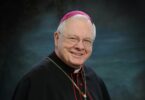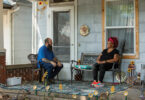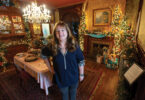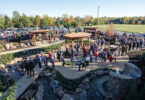
by Olivia Martin
olivia.martin@theleaven.org
KANSAS CITY, Kan. — The way was not clearly marked.
But after getting lost in the English countryside, walking about 100 miles and meeting unexpected people along the way, Father Mike Stubbs, Augustinian Father Peter Jaramillo, Tony Stubbs and his wife Darlene arrived at Canterbury Cathedral in Canterbury, England.
It was June 25 and they had just completed the ancient Pilgrims’ Way in seven days, leading from Southwark Cathedral in London to St. Thomas Becket’s tomb in Canterbury.
Though their experiences were different, the pilgrims were united in their reason for making the journey.
Ancient
Father Stubbs, pastor of Holy Cross Church in Overland Park, his brother Tony and Father Peter’s fundamental reason was simple but profound: love of pilgrimage.
“We were interested because of our experience with the Camino,” said Tony. The three men previously had walked the famous Camino pilgrimage to the tomb of St. James the Apostle at Santiago de Compostela, Spain. And they wanted to relive the beauty of that experience in a new way.
So when Father Stubbs ran across Pilgrims’ Way, it caught his attention.
He learned that around the year 1173, pilgrims began journeying to Canterbury after the martyrdom and canonization of St. Thomas Becket, an English bishop. He was murdered in Canterbury Cathedral and, for centuries, people traveled to venerate his tomb and pray for miracles.
In fact, pilgrimage to his tomb was so popular during the Middle Ages that it is central to one of the most famous and enduring pieces of English literature: Geoffery Chaucer’s “The Canterbury Tales.”
Which, Father Stubbs assured The Leaven, he reread before embarking on Pilgrims’ Way.
Pilgrims’ Way has not retained its popularity into modern times, however.
And that’s because of the English Reformation.
Enduring
In the 16th century, Catholicism became illegal under the reign of King Henry VIII in favor of Anglicanism. Because of this, many Catholic monasteries and churches were destroyed.
Those that survived became Anglican — including Canterbury Cathedral, Southwark Cathedral and others along Pilgrims’ Way.
Father Peter finds the Reformation fascinating and relevant to his own history.
“One reason for me, personally, that I was connected to this [pilgrimage] was because the church in England at the time of the Reformation was a church underground,” he said. “I’m intrigued by that because my family is Mexican.”
During the Mexican Revolution in the 1920s, a severe persecution of the church occurred in Mexico, killing many and causing others to flee.
“My grandfather came from Guanajuato, Mexico, to the United States [during that time] with the hope of religious freedom,” said Father Peter, “and to establish his own life and family.
“I’m intrigued and encouraged by a church that survives under persecution and the blessings that have come from those times — and to be part of those blessings.”
Worthwhile
Despite a tumultuous history, the Anglican and Catholic Church co-exist peacefully today.
“For me, [there was] an ecumenical sense of understanding of the Anglican faith and appreciation of their history [on this pilgrimage],” said Father Peter. “At the same time . . . you sense that there’s something missing. And it’s the fact that the Eucharist isn’t present.
“You sense the absence of the true presence of Christ.”
For Tony, the English countryside itself was surprising.
“It reminded me a lot of around here — the Kansas City area,” said Tony. “There were rolling hills and a lot of forests.”
Now that the group has returned to the rolling hills and forests of the Archdiocese of Kansas City in Kansas, the experience of the pilgrimage endures as a sense of accomplishment and gratitude.
“It was very rewarding,” said Father Stubbs.
Father Peter agreed.
“It gave me a better understanding of some of the English saints,” he said.“Walking to Canterbury was a blessing,” he added.






